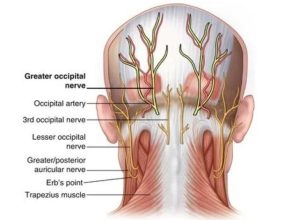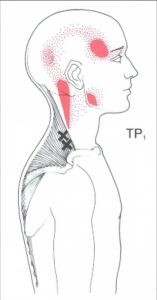
Is my Headache coming from my neck?
In short, yes, it’s certainly possible. Headaches that arise from issues at the neck are known as cervicogenic headaches. The most common structures that can trigger these types of headaches are the upper cervical spine or the musculature surrounding the neck such as the upper trapezius, levator scapula, and the small suboccipital muscles at the base of your skull. When these structures are irritated, overworked, or simply tight, they can irritate nearby nerves that innervate the face and head. This can lead to headaches in the head or behind the eye. Possibly both!

How do I tell if I have a cervicogenic headache?
Most of the time the headache will be on one side of the head and feel like it starts from the base of the skull and wraps around the top of the head to the side. We call this a ram’s horn pattern. Think of the design and location of the LA Rams football helmet but backwards. This is likely where the headache will be. Sometimes the headache will feel like it’s behind the eye too. The headaches will occur with certain head movements or positions, especially if you hold that position for a long time, like when you are sitting at your desk looking at a computer or reading a book in bed.

It’s important to differentiate a cervicogenic headache from other types of headaches like a migraine or a tension type headache. A migraine is a headache caused by blood flow problems to the brain. Migraines can present very similar, if not exactly like a cervicogenic headache. That’s why it is so common for a cervicogenic headache to be misdiagnosed as a migraine and vice versa. Key differences to look for are throbbing type pain, signs that a headache is coming on known as an aura, and other symptoms such as nausea, light sensitivity, and sensitivity to sound. These are all signs of a migraine that are not found with a cervicogenic headache. A Tension-type headache is another form of headache that arises from the musculature of the head. These will present on both sides of the head usually across the forehead and feel like a tight band is around your head. Tension type headaches don’t change with activity and can also present with light and sound sensitivity but usually not both.
Can physical therapy treat cervicogenic headaches?
Yes, it can! Physical therapy is a very effective form of treatment for cervicogenic headaches, and in my experience, it can be very quick. Depending on the source of the headache, either from the upper cervical spine or the surrounding musculature, treatment will likely include cervical spine manipulation/mobilization, soft tissue mobilization, and dry needling. These treatments will help get rid of the headache quickly, sometimes immediately. We then follow up with exercises for the neck and shoulder girdle. These will keep the muscles and spine flexible and strong, preventing future headaches.
What if my headache isn’t coming from my neck, can Physical Therapy Still Help?
That’s a harder question to answer. Unfortunately, physical therapy cannot help with a true migraine. As mentioned above, migraines are issues with blood flow to the brain. These are best treated with migraine medications. Luckily migraine medications are very effective. It is common, however, to have a residual headache despite the effectiveness of migraine medications. These residual headaches may be cervicogenic; and that we do treat!
Summary
Your headache very well could be coming from your neck. These are termed cervicogenic headaches. These headaches usually come from sustained neck positions or movements. They are usually one-sided, start at the back of the head and radiate to the front and side of the skull. Physical therapy is a great treatment for cervicogenic headaches. Treatment will likely include spinal manipulation, soft tissue mobilization, and dry needling combined with exercises for the neck and shoulder. Differentiating between other forms of headache such as migraines and tension-type headaches is important. So, the best course of action is to seek advice from a health professional such as a physical therapist or your medical doctor.
Schedule an appointment with one of our physical therapists for an assessment to see if physical therapy can help manage your headaches!